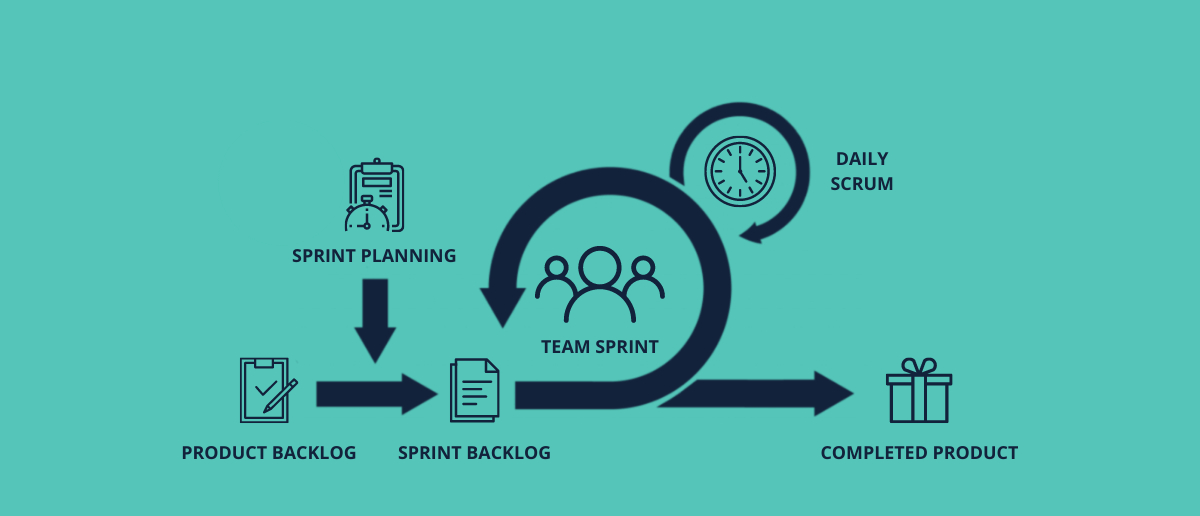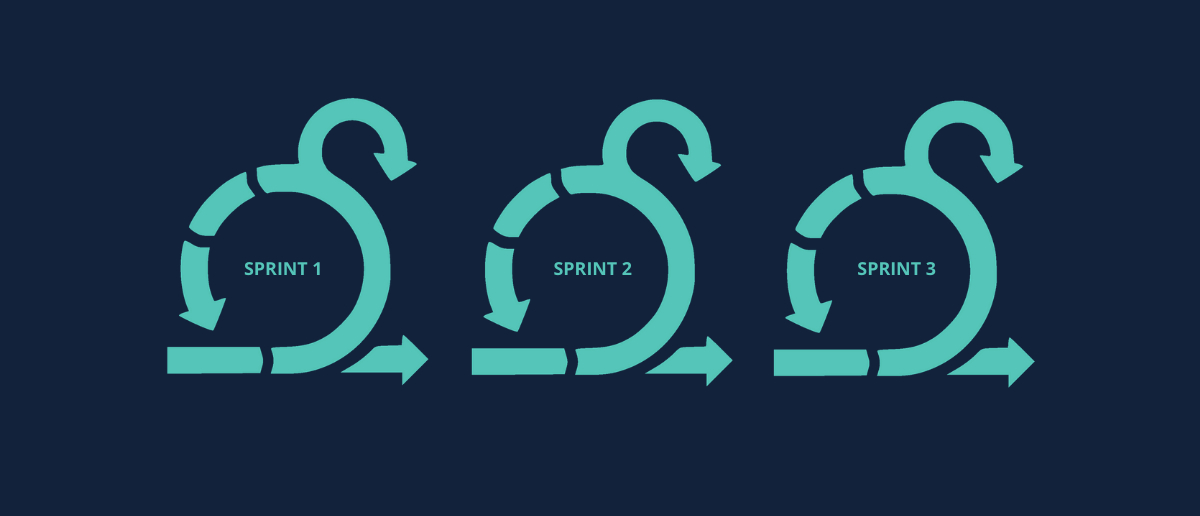
Scrum for Startups: Agile Project Management
Tuesday, 13 July 2021The use of innovative and agile project management processes and theories helps young founders, their startups but also companies to achieve their goals faster. Scrum is one of the agile project management methods. Scrum projects have already been carried out since the 90s. The tool is mainly used in the provision of software programs and services. But in the meantime, the Scrum framework is gaining acceptance in more and more projects and areas, for example in marketing.
The term itself comes from the sport of rugby and is short for “scrummage”.
The official definition according to Ken Schwaber and Jeff Sutherland is: “A framework within which people can tackle complex adaptive tasks and through which they are enabled to productively and creatively deliver products with the highest possible value.”
How does scrum work?
The Scrum methodology focuses on execution, speed, and pivots. The method is also based on the experience that there are projects (especially in software development) that are too complex and multi-layered to be captured in a single project plan. Therefore, extensive tasks are divided into several smaller tasks. Tasks are prioritized according to their relevance.
Just like the Build-Measure-Learn process of Lean Startup, Scrum is iterative. Through constant repetition, the method can improve product quality, increase productivity and shorten time to market.
Unlike Lean Startup, Scrum focuses on the product itself rather than validating hypotheses. Therefore, it is necessary to ensure that the product delivers value to the customer. With the help of sprints and sprint reviews, stakeholder feedback is gathered.
In each sprint, a specific problem from the product backlog is examined to either answer it or break it down into further questions. The challenge of the project management method is to answer the problems by launching the product during the sprint.

Although the Scrum framework contains only a few rules, it provides three fixed frameworks. Each framework contains three roles, five activities, and three types of artifacts.
Scrum Roles
The three roles to be assigned are the Product Owner, the Scrum Master, and the Team.
The Product Owner
He bears the responsibility and is responsible for prioritizing the requirements. He also has to manage product features in the product backlog. At the same time, he needs a deep understanding of the user and is his stakeholder. He must put himself in the user’s shoes and understand his point of view in order to develop a product that the user loves to use.
The product owner is the captain of the ship and thus sets the direction. Finally, he is the one who approves the product at the end of the project and the implementation of the requirements at the end of each sprint.
The Scrum Master
He is the project manager. On the one hand, he ensures that the team has all the capabilities and resources to work operationally and productively. On the other hand, he has to make sure that the team meets the tight deadlines and produces quick results.
However, the Scrum Master does not act as a tamer who orders his team around, but ideally uses the Servant Leadership approach to support his employees in the best possible way.
In the various meetings, he guides the entire team through the process and functions as a moderator. One of these meetings is the Daily Stand-up. Every morning, team members must answer these three questions from the Scrum Master:
- What did you work on yesterday?
- What are you going to work on today?
- Which obstacles are holding you back?
The team members
The core of the Scrum team usually consists of 5 to 9 individuals. The small teams work autonomously and independently. They can decide for themselves how exactly they want to achieve their goal. The team members can decide themselves which Scrum tools, which strategy they want to use, and which tasks they want to complete first.
Team members are required to work collaboratively, self-organised and cross-functionally. But most importantly, they are also required to help their teammates overcome hurdles in addition to their own tasks in order to develop
Scrum Process
The Scrum process consists of repetitive sprints, i.e. value-adding project processes in which the team implements requirements within a short period of time. Individual sprints last an average of two to four weeks. The entire process, in turn, consists of five events, which are also called ceremonies.

1. Sprint Planning
During Sprint Planning, or rather during the associated meeting, the requirements that will be included in the Backlog are defined. The tasks are prioritized and the availability of the individual team members is agreed upon.
The following questions must be clarified in advance
- What will be achieved with this sprint?
- Through which processes will the respective requirements be achieved?
- Which entries of the product backlog will be completed?
The respective sprint begins with this meeting, which lasts approximately half a day.
2. Daily Scrum
Daily Scrums or Daily Stand-ups are, as mentioned above, short daily meetings of the team. This means that every member is on the same level and can present their successes to the group.
3. Sprint
The sprint is the actual work cycle in which the individual subtasks are processed.
4. Sprint Review
At the end of each sprint, the review takes place to present the results to the stakeholders and evaluate them together. The comments and feedback from the Sprint Review are automatically incorporated into the next Sprint to improve the product step by step.
5. Sprint Retrospective
The fifth and final step of the process is the so-called Sprint Retrospective. Here, the team looks back on the Sprint together and develops possibilities to further improve the cooperation.
The Sprint Retrospective differs from the Sprint Review in that no stakeholders are present during this process. This allows for open and honest criticism between team members.
The Artifacts
The following three artifacts allow to keep the orientation during the Sprint process, to work in an organized way, and to record the progress.
1. Product Backlog
The Product Backlog is maintained by the Product Owner and contains all collected requirements. The Product Backlog is a kind of to-do list for the project, but it is not a final or comprehensive list. In the course of the project, new entries will be added as well as other entries that have become superfluous will disappear.
In addition, the Product Backlog is ordered according to the priority of the individual tasks. This means that each entry is sorted according to its usefulness for the final product, so that there are no requirements with the same priority.
2. Sprint Backlog
The Sprint Backlog is derived from the Product Backlog and contains a list of tasks for the respective Sprint. These tasks are the result of the previous sprint planning. In order to maintain clarity during the process, which lasts several weeks, the scope of tasks in the backlog should not exceed two working days. For this purpose, large tasks are divided into smaller subtasks.
3. Product Increment
The third and final artifact is the Product Increment. The increment represents the next expansion stage of the product and should ideally be a deliverable product. It is therefore quite simply the sum of all Product Backlog elements fulfilled in previous Sprints, and must therefore meet all requirements.
Why every startup team should use Scrum
If the flexible project management method with flat hierarchies is not convincing enough: here are a few more arguments to win you over.
Scrum forces the team to acquire knowledge in the shortest possible time and to apply it immediately. As a result, the individual team members expand their competence horizons, and the startup benefits from increased intellectual capital.
Not only the daily sprints and regular consultations with team members have a motivating effect: the frequent achievement of results spurs the team on further. Breaking down complex tasks into smaller steps leads to the celebration of daily small stage successes. So instead of working forever towards a complex goal, developers get regular motivating gratification experiences.
The Retrospective and Review Meetings constantly enable new alignments. Thanks to them, the team learns firsthand, even during the development process, where and to what extent there is a need for optimization. Through this evaluation, developers make no mistake twice.
How can you combine Scrum with Lean Startup and Design Thinking?
All three agile methods basically try to convey the same mindset. It is about checking assumptions with as little effort as possible, understanding user needs, and developing a viable product in a short time. Yet all three have different focuses.
- Scrum has its focus on the product and the customer perspective.
- Lean Startup has its focus on validating hypotheses and developing an MVP.
- Design Thinking focuses on people.
To combine all three, Scrum acts as the framework to engage stakeholders in the sprint, Lean Startup validates hypotheses, and Design Thinking allows to understand the user’s needs.
During the process, it is attempted to go through the 6 phases of Design Thinking in each Sprint and achieve lean validation of the hypothesis(es) through the Lean Startup approach.
In conclusion
Thanks to Scrum, teams can realize software projects quickly and efficiently. The project team is capable to continuously develop and review their own work. But just because the method is well-thought-out does not mean that it works without effort. Without putting work into the planning, preparing the team well, and especially without qualified employees, the success of the sprint is no guarantee.